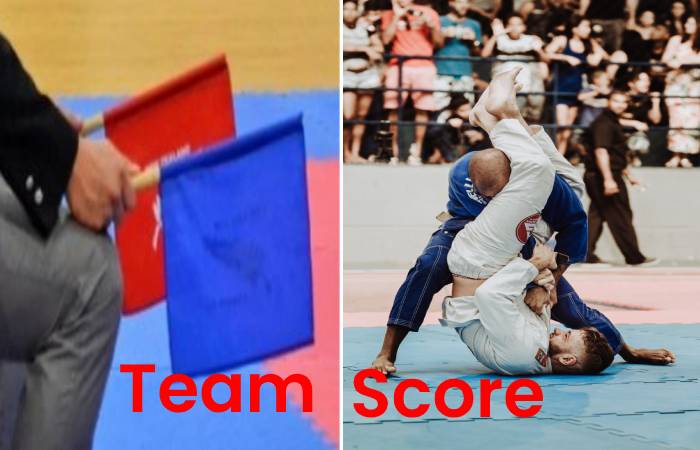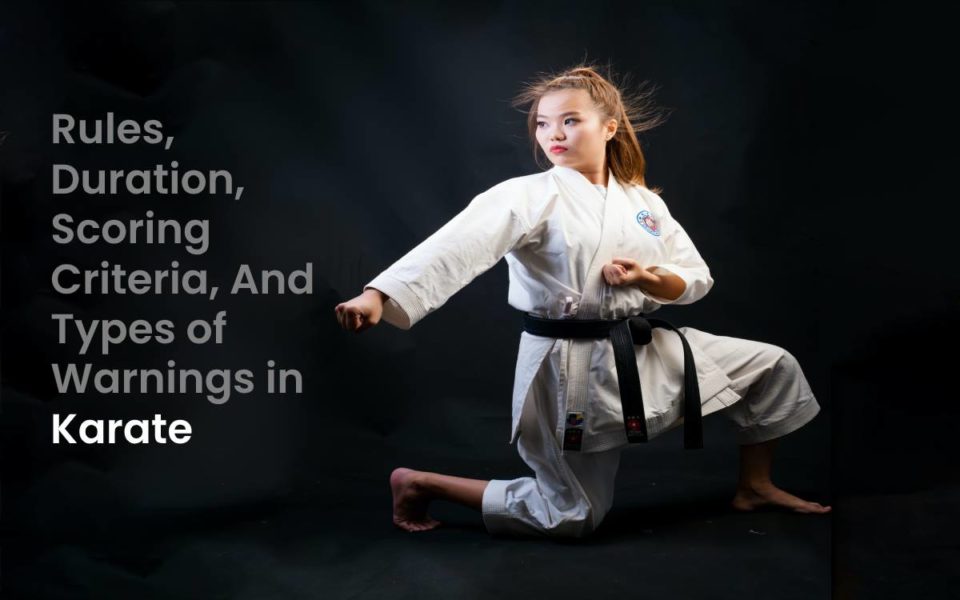As we have already mentioned, Sports Karate can be Kata or Kumite. Although there are Karate rules common to both, such as the competition surface or clothing, most are specific to each of them:
Table of Contents.
Kata Rules
The Katas competition can be individual or in teams. In the latter case, the groups must contain three components of the same gender, either men or women.
In both cases, the competition usually consists of different rounds where two opponents are evaluating and qualify. The one with the best score gets to the next phase.
Competitors must communicate to the judges which Kata they are going to execute, and this must be different in each of the rounds. The use of weapons, auxiliary equipment, or additional clothing is not allowed at any time.
In the case of teams, during the medal matches not only the chosen Kata will be performed, but also a demonstration of its meaning (Bunkai). The maximum time for the set of Kata and Bunkai is 6 minutes, which starts running at the time of the initial greeting and ends after the final greeting. Ignoring either of these two greetings means disqualification (Kiken).
The Katas are valued by five judges who cannot have the same nationality or belong to the same federation of any of the contestants.
The assessment is made based on technical performance (position, technique, transition movements, timing, adequate breathing, concentration, and difficulty) and athletic performance (strength, speed, balance, and rhythm).
Karate Kumite Rules
As in Katas, the Kumite competition can also be individual or in teams.
For the individual, there are subdivisions by age, gender, and weight. Thus in the Senior category (over 18 years old), each gender has 5 pesos ranging from -60 Kg to +84 Kg in the case of men, and from -50 Kg to +68 Kg in that of women.
Each competition between two contestants is called a “match.”
For their part, the teams contain seven male members and four female members. Of these, five and three, respectively, fight in each confrontation. No component of the team is a fixed reserve, and all members may rotate from one round to the next.
In this case, the term ” about ” is designate an individual match between members of two teams to set all rounds.
Karate Rules on Duration and Scoring Criteria

In Senior and Under-21 categories, a men’s match lasts 3 minutes and a female match 2. In Junior and Cadet, they all last 2 minutes.
The contestant who won maximum points at the end of the time wins combat. To achieve these points, you must score, that is, execute accepted techniques on scoring areas of the opponent’s body :
- Head
- Expensive
- Neck
- Abdomen
- Chest
- Rear area.
- Lateral area (sides)
The throat is a scoring zone, but contact is not allowed. In it, a properly applied and controlled technique that does not touch or only has a superficial contact can score.
In Turn, the Scores are Awards According to Six criteria:
- Proper Form: The technique must have characteristics that confer probable effectiveness within the framework of the concepts of Traditional Karate.
- Sports Attitude: Clear non-malicious attitude, as well as high concentration during the performance of the technique.
- Vigorous Application: Power and speed of the technique, as well as the evident desire for it to be successful.
- Perception (Zanshin): Astarte of continuous commitment in which the contestant maintains total concentration and awareness of the opponent’s potential to counter-attack.
- Timing: Performing a technique when it has the most significant potential effect.
- Correct Distance: Point at which the completed technique reaches or near its destination. It is especially important in areas where contact is not allowed.
Scores In Kumite, there are three types of scores:

- Ippon= 3 points.
- Waza-Ari= 2 points.
- Yuko= 1 point.
Ippon is considering the Jodan Kicks, that is, those performers on the face, head, and neck. Also, any scoring technique performs on the opponent, when the opponent has been knocking down, fallen, or lost his balance.
The Waza-Ari is awarding by Chudan Kicks, which are performers on the abdomen, chest, rear area, and lateral area.
Lastly, Yuko is awarding for any punch or attack on any of the seven scoring zones. They call as Tsuki and Uchi, respectively. An individual match cannot end with a tie under any circumstances.
If during a match, one of the contestants reaches an advantage of 8 points, he declares the winner even if the time has not expired. Otherwise, at the end of the match, the winner is the one with the most points.
If both have the same number of points, the winner is the one who made the first point scored without opposition (Senshu). That is, the first contestant to dial without the opponent also dialing before the signal.
When a contestant with Senshu avoids combat so that the opponent does not win, he loses that advantage if he receives a warning in the last 15 seconds of combat. In this case, Senshu cannot be re-granted to any of them.
If no contestant has a point marked by the opposition, then the winner is declared by decision (Hantei). That is, each of the four judges and the referee determines who deserves to win. Whoever gets three of the five votes is the winner.
To make this decision, the judges must rely on:
- Attitude, fighting spirit, and strength exhibited.
- The superiority of the techniques and tactics deployed.
- Which of the contenders has initiates the majority of actions?
Team Score on Karate Rules

In teams, the winner of a round is the one with the most individual victories. If one of them achieves enough triumphs to declare himself the winner, the rest of the bouts are not disputes.
An individual match during team competition can end in a tie. Therefore, it is possible, and there will be equality of victories between both teams. If this happens, the points obtained in all the matches, whether they have been won or lost, are counts.
If the tie persists, a decisive match plays. Any of the team members can dispute this. If it also ends tied, the winner of the same determines in the same way in the individual competition.
Warnings and Disqualifications
In Karate, there are two categories of prohibited behavior:
- When excessive contact occurs and when contact techniques perform on the throat, or attacks on the arms, legs, groin, joints or insteps. Also, open hand attacks to the face and dangerous or prohibited take down techniques fall into this category.
- Leaving the combat area without the opponent’s action, avoiding combat so that the opponent cannot score, verbally provoke the opponent, not obey the referee.
All These Behaviors are Indicating by Karate Rules in Five Types of Warnings:
- Chukoku: It relates to a minor infraction that occurs the first time.
- Keikoku: When a second minor offense of the same category occurs or for offenses not severe enough to warrant Hansoku-Chui.
- Hansoku-Chui: It is a disqualification warning. It usually occurs before infractions that have already received Keikoku in that encounter. Also, if there are serious infractions that do not deserve Hansoku.
- Hansoku: Disqualification as a consequence of a serious offense or a new offense after receiving Hansoku-Chui. In a team competition, it is a score of 8-0 in favor of the unqualified team.
- Shikkaku: Disqualification from the entire tournament, including other categories where the offender has registered. It produces by malicious actions, disobedience to the referee, acting to damage the prestige and honor of Karate or, in general, by actions that violate the rules and spirit of the tournament. In the team competition, the result will also set as 8-0.


